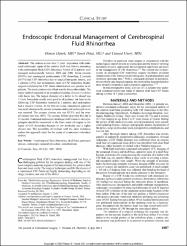| dc.contributor.author | Öztürk, Özmen | |
| dc.contributor.author | Polat, Şenol | |
| dc.contributor.author | Üneri, Cüneyd | |
| dc.date.accessioned | 10.07.201910:49:13 | |
| dc.date.accessioned | 2019-07-10T19:57:57Z | |
| dc.date.available | 10.07.201910:49:13 | |
| dc.date.available | 2019-07-10T19:57:57Z | |
| dc.date.issued | 2012 | en_US |
| dc.identifier.citation | Öztürk, Ö., Polat, Ş. ve Üneri, C.(2012). Endoscopic endonasal management of cerebrospinal fluid rhinorrhea. Journal of Craniofacial Surgery, 23(4), 1087-1092. https://dx.doi.org/10.1097/SCS.0b013e31824e6a44 | en_US |
| dc.identifier.issn | 1049-2275 | |
| dc.identifier.uri | https://dx.doi.org/10.1097/SCS.0b013e31824e6a44 | |
| dc.identifier.uri | https://hdl.handle.net/20.500.12511/3079 | |
| dc.description | 1st Congress of the Confederation of the European ORL-HNS -- JUL 02-06, 2011 -- Barcelona, SPAIN | en_US |
| dc.description | WOS: 000306710200074 | en_US |
| dc.description | PubMed ID: 22777458 | en_US |
| dc.description.abstract | The authors review their 5 years' experience with endonasal endoscopic repair of the anterior skull base fistulas presenting with cerebrospinal fluid (CSF) rhinorrhea. A total of 12 patients were managed endoscopically between 2004 and 2008. Seven patients (58.3%) had nonsurgical posttraumatic CSF rhinorrhea, 2 patients (16.7%) had CSF rhinorrhea due to surgical/iatrogenic trauma, and 3 patients (25%) had spontaneous onset of CSF rhinorrhea. Radio-surgical correlation for CSF fistula identification was positive in all patients. The most common site of leak was the fovea ethmoidalis. The repair method consisted of an extradural underlay closure of a defect with fascia lata. The largest diameter of a defect to be closed was 15 mm. Immediate results were good in all patients, but later in the follow-up, CSF rhinorrhea recurred in 2 patients, and each patient had a revision 2 times. In the first revisions, transcranial approach was used, whereas in the second revisions endonasal endoscopic route was resorted. The primary closure rate was 83.3%, and the overall closure rate was 100%. The average follow-up period thus far is 21 months. Endonasal endoscopic technique well known to otolaryngologists should be considered as the first choice of surgery in the repair of CSF rhinorrhea because of low morbidity and a higher closure rate. The possibility of revision with the same technique makes this approach ideal for the repair of cranionasal osteodural defects. | en_US |
| dc.language.iso | eng | en_US |
| dc.publisher | Lippincott Williams & Wilkins | en_US |
| dc.rights | info:eu-repo/semantics/openAccess | en_US |
| dc.subject | Cerebrospinal Fluid Rhinorrhea | en_US |
| dc.subject | Skull Base | en_US |
| dc.subject | Paranasal Sinuses | en_US |
| dc.subject | Endoscopic Surgical Procedure | en_US |
| dc.subject | Complications | en_US |
| dc.title | Endoscopic endonasal management of cerebrospinal fluid rhinorrhea | en_US |
| dc.type | article | en_US |
| dc.relation.ispartof | Journal of Craniofacial Surgery | en_US |
| dc.department | İstanbul Medipol Üniversitesi, Tıp Fakültesi, Cerrahi Tıp Bilimleri Bölümü, Kulak Burun Boğaz Hastalıkları Ana Bilim Dalı | en_US |
| dc.authorid | 0000-0003-4904-279X | en_US |
| dc.identifier.volume | 23 | en_US |
| dc.identifier.issue | 4 | en_US |
| dc.identifier.startpage | 1087 | en_US |
| dc.identifier.endpage | 1092 | en_US |
| dc.relation.publicationcategory | Makale - Uluslararası Hakemli Dergi - Kurum Öğretim Elemanı | en_US |
| dc.identifier.doi | 10.1097/SCS.0b013e31824e6a44 | en_US |
| dc.identifier.wosquality | Q4 | en_US |
| dc.identifier.scopusquality | Q2 | en_US |


















